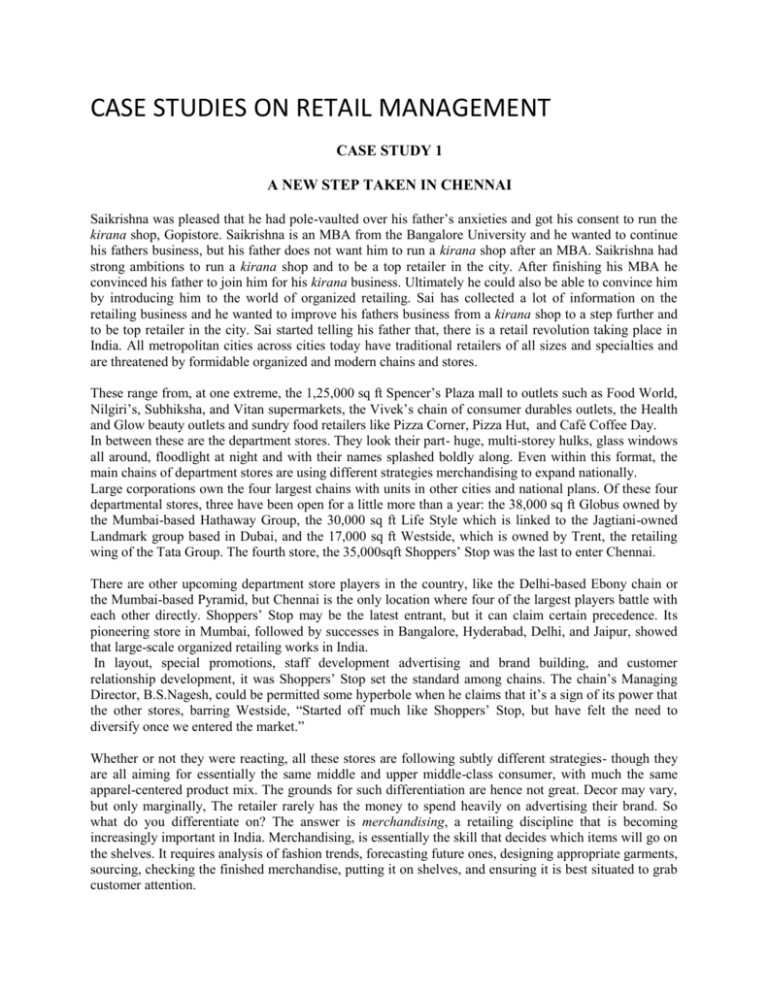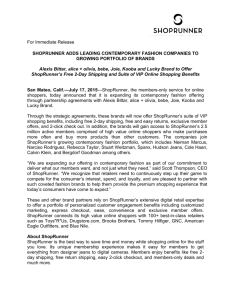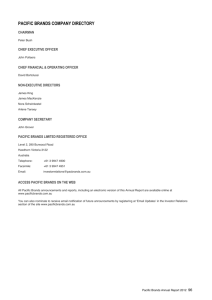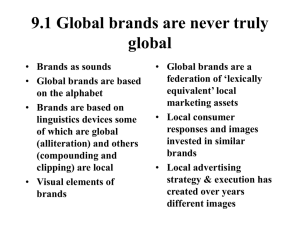CASE STUDIES ON RETAIL MANAGEMENT CASE STUDY 1 A
advertisement

CASE STUDIES ON RETAIL MANAGEMENT CASE STUDY 1 A NEW STEP TAKEN IN CHENNAI Saikrishna was pleased that he had pole-vaulted over his father’s anxieties and got his consent to run the kirana shop, Gopistore. Saikrishna is an MBA from the Bangalore University and he wanted to continue his fathers business, but his father does not want him to run a kirana shop after an MBA. Saikrishna had strong ambitions to run a kirana shop and to be a top retailer in the city. After finishing his MBA he convinced his father to join him for his kirana business. Ultimately he could also be able to convince him by introducing him to the world of organized retailing. Sai has collected a lot of information on the retailing business and he wanted to improve his fathers business from a kirana shop to a step further and to be top retailer in the city. Sai started telling his father that, there is a retail revolution taking place in India. All metropolitan cities across cities today have traditional retailers of all sizes and specialties and are threatened by formidable organized and modern chains and stores. These range from, at one extreme, the 1,25,000 sq ft Spencer’s Plaza mall to outlets such as Food World, Nilgiri’s, Subhiksha, and Vitan supermarkets, the Vivek’s chain of consumer durables outlets, the Health and Glow beauty outlets and sundry food retailers like Pizza Corner, Pizza Hut, and Café Coffee Day. In between these are the department stores. They look their part- huge, multi-storey hulks, glass windows all around, floodlight at night and with their names splashed boldly along. Even within this format, the main chains of department stores are using different strategies merchandising to expand nationally. Large corporations own the four largest chains with units in other cities and national plans. Of these four departmental stores, three have been open for a little more than a year: the 38,000 sq ft Globus owned by the Mumbai-based Hathaway Group, the 30,000 sq ft Life Style which is linked to the Jagtiani-owned Landmark group based in Dubai, and the 17,000 sq ft Westside, which is owned by Trent, the retailing wing of the Tata Group. The fourth store, the 35,000sqft Shoppers’ Stop was the last to enter Chennai. There are other upcoming department store players in the country, like the Delhi-based Ebony chain or the Mumbai-based Pyramid, but Chennai is the only location where four of the largest players battle with each other directly. Shoppers’ Stop may be the latest entrant, but it can claim certain precedence. Its pioneering store in Mumbai, followed by successes in Bangalore, Hyderabad, Delhi, and Jaipur, showed that large-scale organized retailing works in India. In layout, special promotions, staff development advertising and brand building, and customer relationship development, it was Shoppers’ Stop set the standard among chains. The chain’s Managing Director, B.S.Nagesh, could be permitted some hyperbole when he claims that it’s a sign of its power that the other stores, barring Westside, “Started off much like Shoppers’ Stop, but have felt the need to diversify once we entered the market.” Whether or not they were reacting, all these stores are following subtly different strategies- though they are all aiming for essentially the same middle and upper middle-class consumer, with much the same apparel-centered product mix. The grounds for such differentiation are hence not great. Decor may vary, but only marginally, The retailer rarely has the money to spend heavily on advertising their brand. So what do you differentiate on? The answer is merchandising, a retailing discipline that is becoming increasingly important in India. Merchandising, is essentially the skill that decides which items will go on the shelves. It requires analysis of fashion trends, forecasting future ones, designing appropriate garments, sourcing, checking the finished merchandise, putting it on shelves, and ensuring it is best situated to grab customer attention. As H. Ramanathan, Managing Director, Life Style International, says, “customers don’t realize that in retailing, 80% of work is done behind the scenes to get the products on the shelves”. Merchandising along with information technology have been key areas for investments. Shoppers’ Stop has gone to the extent of recruiting professionals from abroad to spearhead their merchandising efforts. Globus and Westside have both invested significantly in developing their merchandising team, while Life Style has benefited from its association with Landmark, one of the largest retailers in the Gulf. Ramanathan says that they don’t apply international expertise blindly to India. He says, “we take into account, for example, issues like the way Indians seem to need more customer service from our employees”. Most of Life Style’s senior management team, including Ramanathan himself, have been posted to India from international operations of the chain, while people from India have also gone abroad for training in areas like merchandising. The key merchandising decision that these stores had to take was between selling own label brands or other companies’ brands. Own label is the classic retailing strategy, where all the products stocked have either the same brand as the store (as with Gap), or store developed brands (as with Marks & Spencer’s – the St Michael label). In India, apparel retailers ranging from Charagh Din to Arvind Mills have had success with this strategy. It allows for higher margins as the retailer controls manufacturing. But Nagesh points to the limitations as welll: “a brand, through its multiple activities has created an image of a lifestyle that the consumer has come to expect. It’s very difficult for a retailer, with his limited resources, to do that”. By stocking other brands, retailers avoid the headache of manufacturing and marketing, concentrating instead on their core competency of providing a good retailing experience. It is the rapid way to enter retail, and ensures a product range with a guaranteed level of acceptance. For example, from the onset in the Indian market, Shoppers’ Stop concentrated on other brands, which account for around 80 % of its stock. The store has gone in for its own brands principally in areas where general brands are weak, like women and children’s wear. The store plans to extend its own brands from the current ‘Stop’ and ‘i’ labels to include labels like Kashish for ethnic wear and Life for fashion. But Nagesh has no doubt that non-store brands will remain its basic business. The same goes for Life Style, which has not developed store brands specifically for the Indian market but only stocking some own label brands that are anyway being manufactured for Landmark’s international stores. The same goes for Life Style, which has not developed store brands specifically for the Indian market, only stocking some own label brands that are anyway being manufactured for Landmark’s international stores. According to Ramanathan, the proportion varies depending on the level of acceptability of local brands: “in household products it’s as much as 80% own label because of the lack of good local brands. On the other hand, with men’s apparel where there are a lot of good brands, it’s just 20 % with women and children’s wear it’s around 50% That’s the opposite of Westside’s strategy. The store’s genesis was in the manufacturing operations of Little Woods, a major British retailer, which Trent took over along with their single store in Bangalore. Westside struck to Little Woods own-label strategy, with most products in the store under the Westside label, or variants of the umbrella brand like West Sport. Ajay Mehara, Vice-president, Marketing, admits that this is a harder strategy, but insists it makes long-term sense. “In the next five to ten years, if all retailers offer the same brands, the main differentiator will be location and customer service.” Frankly, these are not great differentiators, so we’d rather have something more basic, like a product range that customers could only get from us.” The store does not rule out stocking other brands, Mehra says, “but only if they could be exclusive to us.” Mehra admits that higher margins of store brands tend to be nullified by extra marketing cost. But it opens a franchising option for the company. While Westside doesnot have immediate plans to do this, Mehra says its something they could think of in the long term, “perhaps for smaller format stores in cities where we have already established a main store.” Globus’strategy lies in between, but is increasingly tending towards own brands, Ved Prakash Arya, CEO, Globus admits, “A lot of people are not satisfied by existing brands which aren’t offering the products they want, or at acceptable prices.” The company has invested heavily in developing its own products, particularly for Pavilion, the second store format, launched in Chennai. Pavilion offers value-for-money apparel, entirely under its own brand name. An extensive merchandising system has been put in place for Pavilion – the merchandising team is entirely separate from Globus. But with this level of expertise, it seems likely that Globus will increasingly be leveraging this to move towards, if never entirely to, the Westside model. The other important merchandising decision a store must make is which basic categories it will give prominence to. Apparel is at the heart of all these stores, but they have other categories as well. Life Style in particular, emphasizes its household products, shoes and children’s apparel ranges. It’s leveraging the advantage it gets from its international partner, which has specialized retailing formats for all these categories. So it’s simply a matter of applying this experience, and quite often the same products sourced by its global operations, to its Indian stores. International contacts give it another advantage in a critical area or recruiting and retaining good staff. Life Style is able to offer employees the chance of moving abroad as their careers develop. “Quite a substantial motivational tool,” notes Ramanathan. Nagesh for one admits he rather envies Life Style this advantage, particularly with household products, “it’s an area of the future, “he says. Shoppers’ stop will be expanding its household products’ though not to the extent of Life Style. “Our focus will always be firmly on apparel, “says Ramanathan. The other area, which the store has been expanding is its accessories and cosmetics business. Nagesh says this is not from a profitability point of view. But other big differentiator Shoppers’ Stop has put into its Chennai store is the sale of books and music. It’s tied up with the RPG group-owned Music Word to open a store on one floor of the Shoppers’ Stop outlet. Alongside, it’s placed an outlet of Crossword, the Mumbai-based bookstore chain that the Raheja group took over from India Book house earlier this year. The store pioneered this combination in Hyderabad, and is enthusiastic about it. Nagesh says it rounds out their offering, giving customers more reasons to come to the store. Life Style also offers books and music in Hyderabad, but Nagesh emphasizes the importance of offering them through separate stores. They bring a different type of customer- and a critically important type. Book, and particularly, music do more than just bring customers to the store. They bring a different type of customer- and a critically important type. “We had realized that our store was good at appealing to the 25-35 age group, but not the 15-25 group,” says Nagesh. That mattered because these were the important future customers and if they had the impression that the store was too old for them, it was setting itself up for future trouble. Music is now bringing in the younger crowd, which is why in Mumbai the store has tied up with the Planet M chain of music stores. “We will continue to have such tie-ups, with Planet M in the North and West and Music World in the South,” says Nagesh. Lessons like these, learned on the Chennai battlefield are going to be critical as the stores continue their roll-out across the country. Shoppers’ Stop had to open two more suburban stores in Mumbai, in Ghatkopar, followed by Bandra next year, as well as a second Delhi store. Westside recently added to its original four stores in Bangalore, Chennai, Hyderabad and Mumbai, one store in Pune, and plans to go to Delhi and Kolkatta. “Our aim is to have 12 stores by 2002,” says Mehra. Life Style plans to go in regional blocks. Its Bangalore store had opened in the first quarter of the year 2001, and Ramanathan says they might consider a fourth southern store “may be some where like Coimbatore.” After that they’ll move north, to Delhi, and maybe Chandigarh. “Obviously we’ll have to look at Mumbai at some point, but the property scene is really tough,” says Ramanathan. Globus will move more slowly. It started with stores in Indore and Chennai to experiment with small versus large towns. Arya says the Indore experience has been mixed. They have no competition in the city, and as its largest store Globus is seen with pride and has huge customer loyalty. “But large stores need large footfalls, which aren’t always immediately available in smaller towns,” Says Arya. Their next venture will be in Mumbai. The battle goes on. Ramanathan for one welcomes the prospect “All these stores have actually helped each other,” he says. “It’s created a tremendous awareness in Chennai. People have become comfortable shopping in them, and together they have helped create a culture for large scale retailing in this city.” Now it’s going to happen in other cities as well. Sai took his father in to the world of organized retailing and got his consent to run his kirana shop. When his father understood about the organized retailing and saw all shops, he felt like he should support his son and made up his mind to invest to his sons idea. Sai bought land (10,000 sq ft) at the cost of Rs.10,00,000 in his city, that city is a District place with a population of 4,00,000 and is 75 Kms away from Bangalore. He constructed a two-floored building and invested 40,00,000 for the one stop shop retailing his was combination of super market and discount store. The store is being inaugurated by a famous Kannada film star. Will Sai become the top retailer in the city? Do the shops around the store affect the business? Does this concept of retailing work in the small District? Has Sai made the right decision?








